Ask the Composers: Danny Bensi & Saunder Jurriaans Discuss Their Four Films at Sundance 2016
It is an understatement to say that New York-based composer duo Danny Bensi and Saunder Jurriaans are at the top of their game. While most in the film industry count it a high achievement to show one film at the Sundance Film Festival, Bensi and Jurriaans had a whopping four films at Sundance 2016. During the festival, Bensi and Jurriaans talked to ScreenPrism about the different soundscapes of their Sundance scores, why they’re drawn to writing music for conflicted female protagonists and how they became the go-to composers of the New York indie film scene.
ScreenPrism: Can you talk about the scores of the four films playing at Sundance and how they compare?
Danny Bensi: They are all completely different, which is awesome. Especially as we are moving on in our careers now and doing more and more films, it’s really important not to be pigeon-holed, and we don’t want to be pigeon-holed in any genre. So these four are totally different from each other. One of them is kind of a thriller, Frank & Lola (2016). It has a little bit of a jazz aspect to it, but also some orchestral stuff hanging on.
Then we did another film called Christine (2016), and that doesn’t even have any bass instruments. That’s harp and clarinet and all these little trinkets of percussion. It’s all very beautiful and feminine music. It doesn’t have any thriller things going on. It’s a beautiful score that we’re really proud of, so that was fantastic.
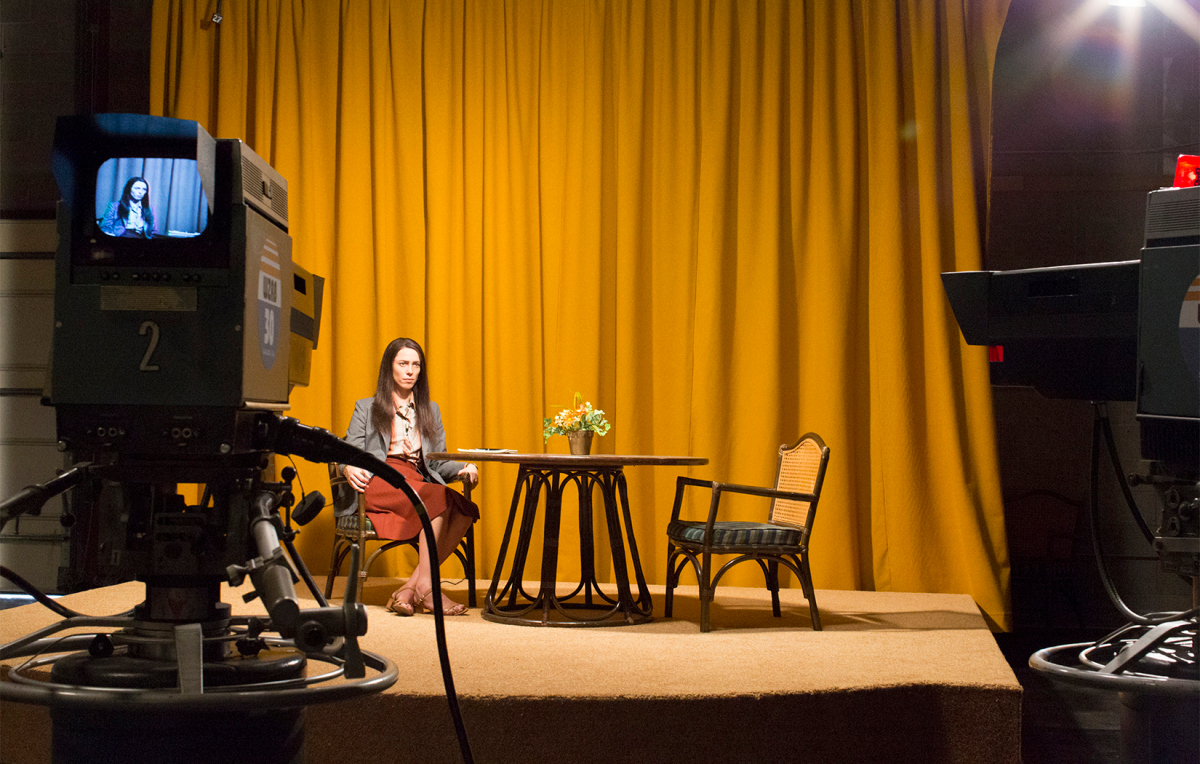
Christine (2016)
Saunder Jurrianns: The Fits (2016), which we saw today – we scored that back in June, and we never saw it completed, so that was so exciting today to see it. That was a really exciting score, and we got to experiment with a lot of weird instruments. It was mostly clarinet, some weird strings, weird sounds that we made slowed down. It’s a really avant-garde score, a super expressive score. A lot of breathing. Movement is a huge part of the film, so we tried to embody that sense of… it’s about dance in a way. We tried to get that corporal sense into the music. We have some breathing rhythms happening, some clapping and body drumming. The lead instrument is a clarinet that’s played very rudimentarily.
And then Complete Unknown (2016) – it’s vibraphone and some guitar and some tones. It’s a pretty emotional score.
DB: Again, quite a feminine score, if feminine means anything to anybody; I don’t know if that’s a word you can use to describe music or not. But again, it’s not a lot of bass instruments, lots of high end celestial, ethereal sounds. Rachel Weisz’s character is this social chameleon person who keeps changing her life and moving to different cities and changing her profession and changing her identity, so there’s this whole story about that, and she is a little lost. So it’s all about her the score, and the film. Michael Shannon is in it, too. But as far as music is concerned, it’s very melodic but ethereal at the same time.
SJ: It doesn’t have that thriller drama going on. It’s just very introspective and thoughtful.
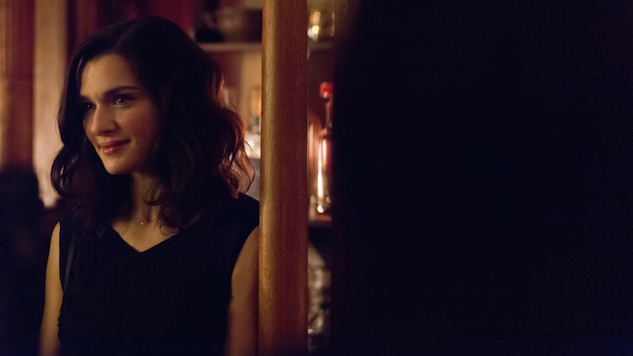
Rachel Weisz in Complete Unknown (2016)
SP: What does that make the audience feel when the music is more ethereal with less bass?
DB: It draws you into her and trying to understand what she’s going through, as the audience makes up its mind about whatever she’s going through. It’s weird what she’s doing, but you are kind of intrigued by it, like what happens if I just rip up my ID card and my passport and go to another city or country and start fresh? Nobody knows who I am, change my name, change my accent. As an audience member watching the film, you’re like, “What would that be like?” You want the music to help you think about whether you think that’s a good thing or a bad thing, whether you would do it yourself. So you make her an interesting character using the music.
SJ: Josh Marston, for this film, he chose with us very specific moments for music that were very open moments in the film. It wasn’t underscoring as much as, like, this now is a moment for music to draw you into her character. We would almost tell little stories with each cue and bring you through a range of emotions. One thing he kept saying to us was he wanted the music to be complicated. Complicated can mean a lot of things — complicated instrumentally, complicated technically, musically complicated — but I think [this film] was more emotionally complicated.
SP: Do you often start from the character, with a leitmotif of character?
DB: For that movie, I guess we did. But it’s more about getting a right texture of sounds, choosing the instruments that work: start with piano, then scratch the piano, then do some guitar, scratch that. Then slowly you start getting the sounds together and seeing what works. As we talked about the ethereal world [in Complete Unknown] before, what kind of ethereal, thoughtful, emotional world does she live in? You start to figure out what that is.
SJ: And out of that will come a melodic theme, or a textual theme—it doesn’t always have to be a melodic theme. Telling the story, we are another actor in the film. We are either able to reinforce a particular character or more than one character, or we can tell from outside from another kind of omniscient view.
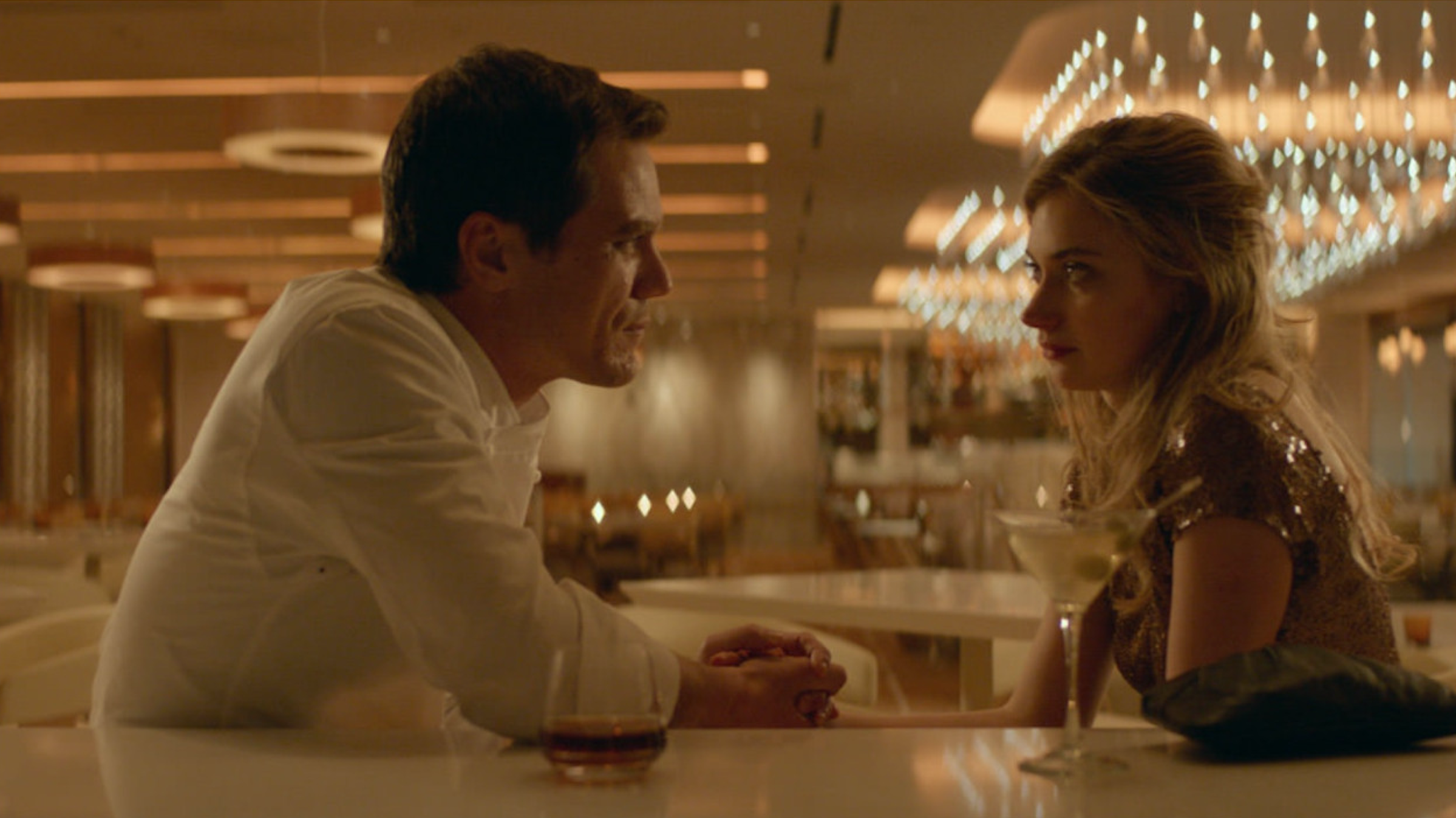
Frank & Lola (2016)
DB: Frank & Lola has an old-school film score, doesn’t it? The director, Matt Ross, really liked the old French composers from the sixties and stuff, slightly over the top orchestral, very emotive stuff. So we have a melody for Frank and Lola’s relationship. We have a melody — it starts at the beginning of the film, lays it out on the table as they set everything up for the viewers, and then you pick apart that melody and then develop it as the film goes on. And then you bring it back at the end for the grand finale. Old school. That’s what we did for that — it was super fun.
SP: What’s your process of working together and when do you come into the film?
DB: We get a rough cut that’s almost done, maybe some editing still needs to happen.
SJ: Sometimes we get a final cut.
DB: It’s always different, but generally it’s never less than 80% done. So we have a pretty good idea. They have temp music in there sometimes to help the editor to choose the pacing of how it’s all gonna happen. Sometimes it’s our music that’s the temp music in there, and sometimes it’s other stuff that they’ve grabbed from the internet, and then we come in and take all of the temp out and start work. We start from the beginning, we start from the end, we start from our favorite scene.
SJ: It’s always different. It depends what inspires us in the beginning.
DB: Often we’ll split it up, so maybe Saunder’s like, “Oh, I just had a go at the beginning, what do you think?” and then I will come in and listen and say, “I really like it, let me get in there on the computer and do some things that I think would be cool as well,” and then we develop it together. Then we send it to the director and see what he or she thinks. Then we get the feedback. They like this, they don’t like this; then given that information we can move on to some other cues and start developing some ideas. We just pass the cues back and forth, work together.
SP: So it’s mainly an instinctual trial and error?
DB: Yeah, you just get the vibe or you don’t. You say, I really want to try that scene, and then you jump to the end of the film and say, I’m going to try the end, check it out.
SP: Does the director tell you beforehand “I want the audience to feel this emotion or this idea to come across”?
SJ: Sometimes, but not always. That usually happens next, once we get a nice body of initial work to send them. Then they come in, and we go over what they like about it, what they don’t like, but we also get into specifics of what scenes we’re scoring. We usually like to get a general sense of what is the palette of this movie going to be before we really get into specifics.
SP: Do you play the instruments yourselves? Do you also use computers?
SJ: Some of them. We record into Pro Tools, which is a computer program, and we manipulate most of the sounds. We don’t use synthesizers, though. 95% is live recordings.
SP: How did you start working together as partners, and when did you know you wanted to write music for film?
DB: We played in a band together for many years. We started around 2001, 2002 in NY. We had met a couple of years before that, but we were playing in a band for many years, making tons of music and cutting albums. So we were already recording with each other and making music, and then one of our friends asked us to score his film. That was about six years ago. And we loved it, and we wanted to get into it, and it started snowballing. It went really fast.
SJ: We never really set out to do it. It just kind of happened. Now it’s all we do.
SP: How did you get involved with these four films playing at Sundance?
SJ: All these films are New York directors. We are based in New York. We’ve built a really wonderful family of people we work with there. It really started with Borderline, Two Gates of Sleep (2010), which was our first film, and then we went on to do Martha Marcy May Marlene (2011), and through that we met a lot of other people in the New York film scene – it’s very small.
DB: These films are completely different from each other, but I guess there is a quality about them, a sort of humanistic quality about all four, that sort of strings them together, about these characters.
SJ: One of the most important things to us is to get along well with the people we work with. What makes a good score is our relationship with the people we’re working with. Coming to Sundance, celebrating with thos people, is what cements the new project for us in general.
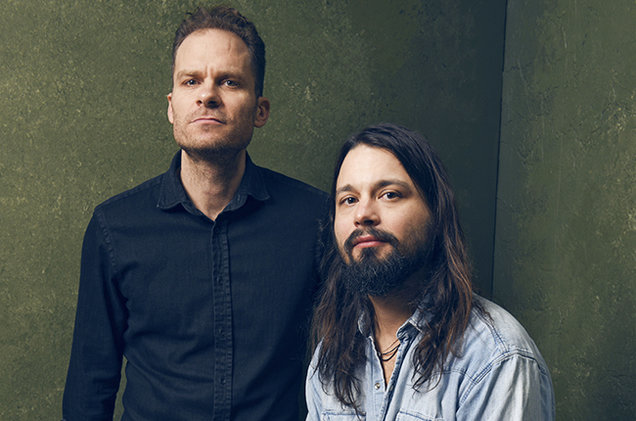
Danny Bensi and Saunder Jurriaans
SP: How long does each film score take?
SJ: Two months at least. We’ve done them in less, in like three weeks before, but average is two months. A couple of these movies, one of them we spent four months on.
DB: There are some films that just don’t get done. We have to move on to other projects and come back to it. Because sometimes they re-open a film, re-edit it, change stuff. We’ve seen all kind of weird things happen. We’re like, we thought we finished that film, but they want you to re-do the end.
SP: Do you find a big difference between the indie LA and NY film scenes?
SJ: We’ve done a bunch of films in LA with LA crews, and they’ve been really fun too, great people to work with as well. I wouldn’t say either is better. They’re different. The New York vibe, the indie film scene, is definitely darker, gritty.
DB: I wouldn’t say there’s a big difference, though.
SP: Are there any moments in these films where the music is doing something interesting that people might not notice at first?
DB: Nothing that they wouldn’t really notice by themselves. Our favorite moments are the audience’s favorite moments, too, probably. Like that moment in The Fits that we watched today where she is on the bridge, and she has been trying the whole film to learn a new dance that all the other girls are doing, and she hasn’t mastered it yet. She is on this bridge by herself, it’s an overpass on the freeway, and it’s all kind of gritty. And she starts dancing, and you see she is about to get it, and she repeats it and she repeats it again. It’s really intense, and the look on her face, she starts to smile, and we have this whole clapping, percussive, body-clapping thing. We’d been using clarinets earlier in the film, and the clarinets suddenly join again, and now they’re helping her. Before that they had been really sparse and weird-sounding and avant garde and atonal. Then suddenly they’re in, and they are supporting her with the percussion. It’s a really inspiring moment. I love that moment. We were like “Whoa, we did that?”
SJ: It was also super exciting to see that movie today because we got to see what the sound designer did, Chris Foster. He did just a phenomenal job and really elevated our music.
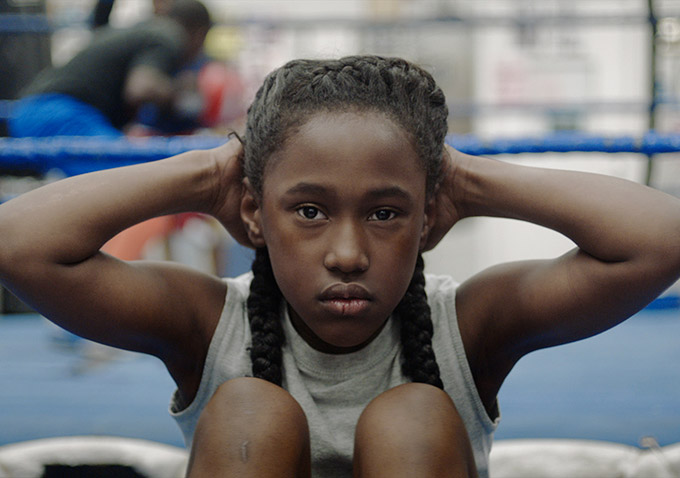
Royalty Hightower in The Fits (2016)
SP: Any favorite moments in Christine?
SJ: The first half of the film is frantic, energetic, percussive music, driving home the fact that [Christine] is totally neurotic. So you’re feeling very nervous – the whole film is anxiety-ridden. But there’s one point where she finally has this pretty big breakdown, and there is a cue the day after – it’s her coming to work the day after – and it’s almost this weird, impressionist, soft, beautiful piece that’s illustrating these camera moves that are happening. That’s a really big turning point in the film. Not only is it one of the most beautiful, complete pieces in the film, but it’s also a big turning point for the score. The score becomes a lot more emotional and dark after that.
DB: All the music from there on is softer, the textures are more orchestral. Now that we’ve come to terms that… you understand that she’s not okay, the music kind of accompanies that. Until that, it’s frantic, and then from then on, all the cues are beautiful, impressionist things. But not super descriptive, like “This person’s crazy.” It’s all beautiful impressionist music. It’s juxtaposition.
SJ: That was a really interesting character to write music for. Rebecca Hall does such a phenomenal job. She has this amazing humorous side, and she’s weird and she’s funny and she’s crazy, and she has this really dark side. For us to score that is pretty interesting. The main theme is a very childlike melody.
SP: How would you describe the atmosphere and style of Martha Marcy May Marlene‘s score?
SJ: We were still learning how to do it – that was our second or third movie. We did it in my living room in Brooklyn. There was a lot of layering of strings and then taking a lot of stuff away.
DB: We didn’t even have a voice yet, what we thought or what kinds of music we were capable of making. We certainly weren’t trying to copy anyone – we were just like, “What do we want to do here?” I remember this piano piece came up, which is one of the main things, and the melody is kind of nocturne-y, French-sounding. It’s a melody that makes a little statement, questions that statement, makes another little statement, and then that one is questioned is well. And then we were like, does that make sense for our character, this person who is going through this weird identity crisis? Yes, this works.
One of our main cues for Martha Marcy May Marlene, is when she’s walking across holding the bucket, it’s halway through the film, and this very sort of Russian, avant-garde orchestra with cellos comes in. It’s very dark and strange, and it goes with the cinematography and the weather. And you’re just like, “What’s happening in this camp? What is going on?” And that piece of music takes you on that journey. That was one of our first pieces where we were like, “Ah, this is what we like, these weird strings.” And then we went on to do Enemy (2013), which used a lot of that tonality.
SJ: Thinking about it now, a lot of the films that we end up scoring have a very similar strong female lead, a conflicted female lead. Christine, Complete Unknown, The Fits, even The Gift (2015) – we did The Gift over the summer. It’s also very centered on Rebecca Hall’s character.
SP: Do you look to any other film composers as role models?
SJ: We love Johnny Greenwood’s scores, P.T. Anderson’s stuff. That’s some of our favorite stuff.
DB: The greats like Hans Zimmer… we like those guys, but we’re not like, “What would they do?” We like listening to that stuff, but it’s more about modern composers. We think of making modern music, interesting orchestral textures, interesting sounds. Jóhann Jóhannsson’s great at creating wonderful beds of music, tonal soundscapes. His last movie, Sicario (2015), had these beautiful double basses coming in. Scott Walker.
SJ: Our friend Brady Corbet made a film last year, The Childhood of a Leader (2015), and the score [by Walker] is phenomenal.
DB: Tons of double basses. It’s really interesting – what can you do with a bunch of double basses? We love that.
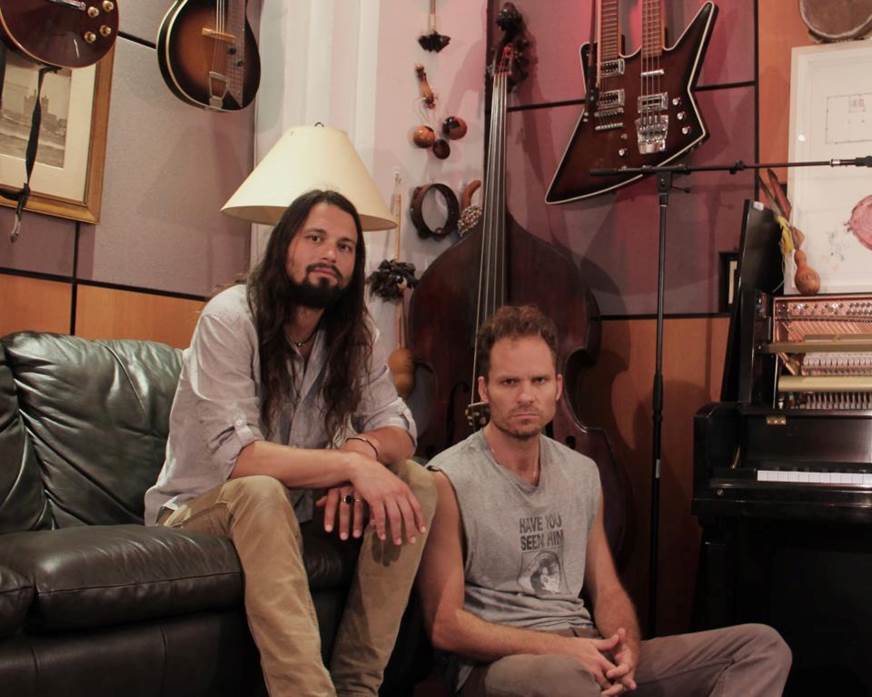
Jurriaans and Bensi

